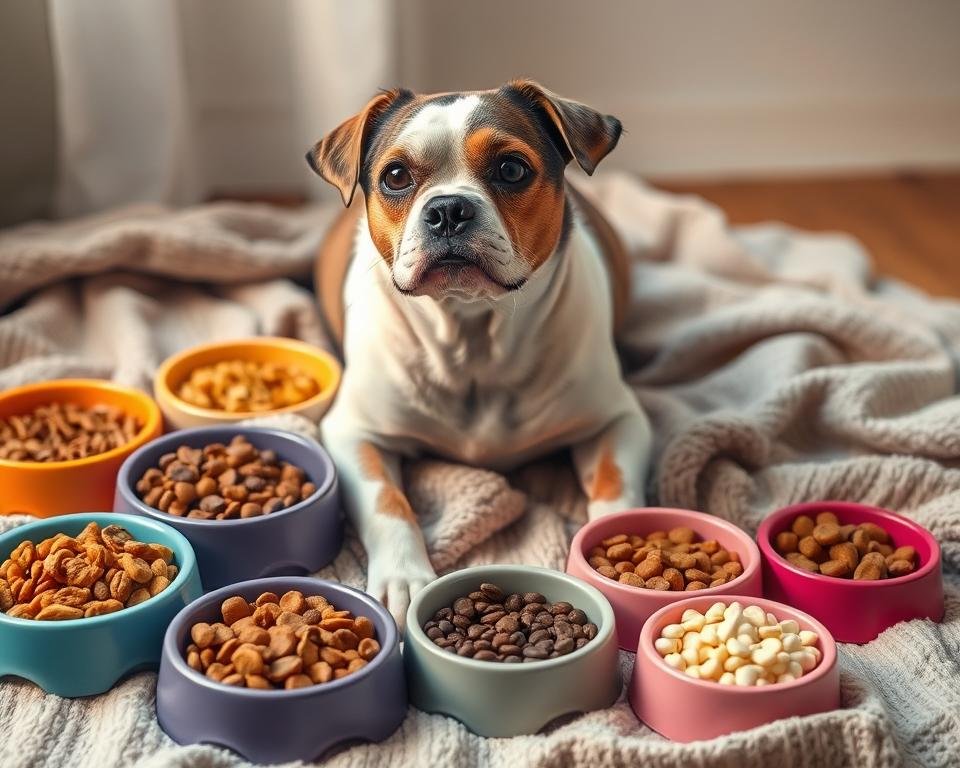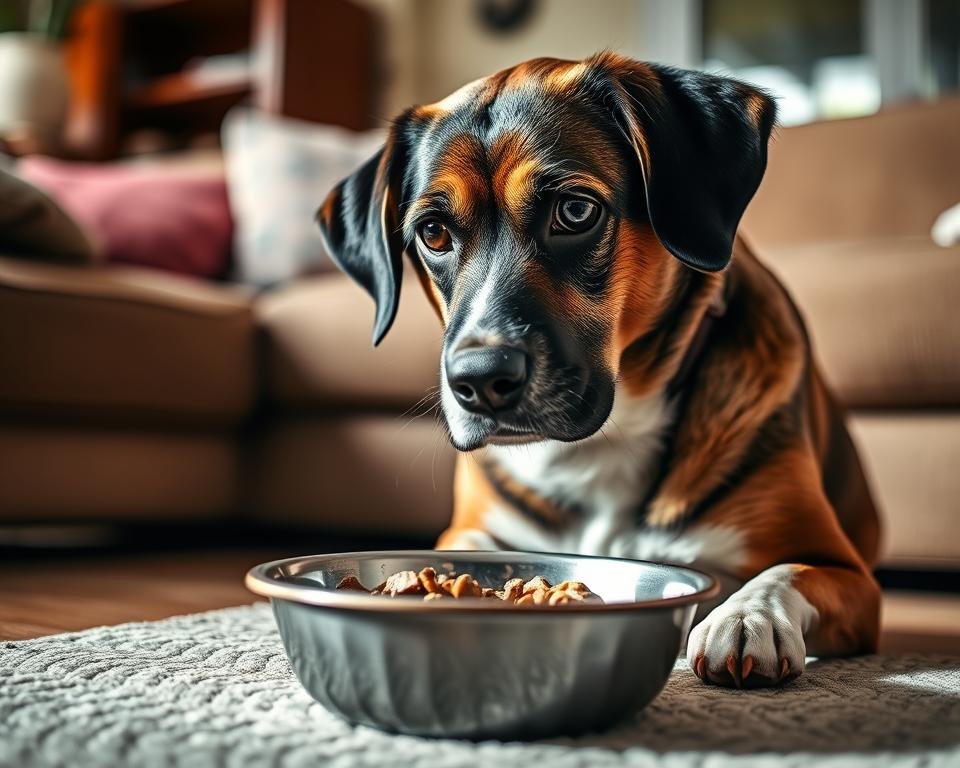Keeping a dog’s appetite healthy is key, even when they’re not feeling well. If a dog stops eating, it can lead to serious health problems. This is true for dogs on medication that needs to be taken with food.
If a dog suddenly stops eating or eats much less, it’s important to see a vet. Dogs can usually go 48 hours without food, but it’s important to watch them closely. This can quickly become a serious issue.
In this article, we’ll look at ways to get a sick dog to eat. We’ll cover common reasons for loss of appetite and practical solutions. Our goal is to help pet owners keep their dogs healthy and happy.
Understanding Why Sick Dogs Stop Eating
When your dog is sick, it’s worrying to see them not want to eat. A healthy appetite is a sign of a healthy dog. There are many reasons why sick dogs may lose their appetite. Knowing these reasons can help you support your dog better during their recovery.
Common Causes of Loss of Appetite
Many health issues can make dogs lose their appetite. These include respiratory infections and upset stomachs from antibiotics. Dental problems, like broken teeth or gum disease, can also make eating painful.
Health Risks of Not Eating
Not eating for a day or two can be serious, even for small dogs. It can lead to liver and kidney problems. These are life-threatening if not treated.
When to Be Concerned
You should worry if your dog hasn’t eaten for 48 hours. Also, if they stop drinking water and don’t urinate for 12 hours. These are signs they need vet help right away.
Keeping your dog’s appetite during illness is key for their recovery. Knowing why sick dogs stop eating and when to get help is important. With the right care, your dog can get their appetite back and be playful again.

Signs Your Dog Needs Immediate Veterinary Care
If your sick dog stops eating and won’t try anything, call your vet right away. Not eating at all can mean a serious illness. Other signs that need quick vet care include not drinking water, not going to the bathroom for 12 hours, vomiting, or showing a lot of pain.
Abdominal swelling can mean serious problems like bloat or peritonitis in dogs. Signs of heatstroke include fast breathing, a lot of drooling, vomiting, and trouble walking. Seizures can be caused by many things, like poisoning or brain issues.
If your dog not eating shows any of these symptoms, get vet help fast:
- Pale gums, feeling tired, not wanting to eat, and getting tired easily (signs of anemia)
- Limping or dragging feet (could mean pain or injury)
- Discharge from different parts of the body (could be an infection or infestation)
- Bite marks (could mean infection or poisoning)
- Severe bleeding (needs quick treatment)
- Showing a lot of pain, like yelling or being very protective
- Quick weight loss (could be a health issue)
- Collapse or fainting (a very serious sign that needs immediate help)
If your sick dog shows any of these signs, call your vet right away. Quick vet care is key to your dog’s health.

How to Get a Sick Dog to Eat: Essential Strategies
When your furry friend is sick, it’s hard to get them to eat. But, with the right methods, even the pickiest dogs can start to enjoy their meals again. We’ll look at key strategies like hand-feeding and creating a cozy eating space to help your sick dog feel better.
Hand Feeding Techniques
Hand-feeding small amounts of gentle foods for dogs can really help. It shows your dog you care and can make them more interested in eating. Start with tiny bits of their favorite food, gently putting it in their mouth. This can make them more willing to eat when they’re not feeling up to it.
Creating a Comfortable Feeding Environment
The place where your dog eats can affect their appetite. Choose a quiet, familiar spot for their meals, away from distractions. Make sure it’s clean and comfy, with their water bowl close by. A calm, familiar setting can make your dog more likely to eat.
Temperature and Timing Considerations
The temperature and timing of meals matter too. Warm their food slightly in the microwave for 10-30 seconds. This makes it smell better and taste more appealing. Give them small meals often, like 1-2 spoonfuls every hour. This makes eating easier when they’re not hungry.

“Patience and a gentle approach are key when trying to get a sick dog to eat. With time and the right techniques, you can help your furry friend regain their appetite and get on the road to recovery.”
Enhancing Food Appeal Through Aroma
Dogs use their sense of smell to decide if food is tasty. To make your sick dog’s meals more appealing, try heating up wet food or adding warm water. You can also add strong-smelling ingredients like tuna or salmon. If your dog’s nose or eyes have discharge, clean their face. This helps them smell food better.
Another good trick is to put a little food on your dog’s mouth. This can make them want to lick and taste it. By using their sense of smell, you can get them to eat again.
- Heat up wet food to release more aromas
- Add warm water to dry food to boost scent
- Include strong-smelling ingredients like tuna or salmon
- Clean your dog’s face if there’s discharge to improve their sense of smell
- Smear a small amount of food on their mouth to trigger tasting instinct
Using your dog’s sense of smell can make their meals more appealing. This can help them eat even when they’re not feeling well. By changing the smell and look of their food, you can help your sick dog get better.

Best Food Options for Sick Dogs
When your furry friend is feeling sick, the right food can help a lot. Choose bland, easy-to-digest foods. Boiled chicken with rice, lean ground beef, or mashed sweet potato are great choices. They’re gentle on the stomach.
Bland Diet Recommendations
- Boiled, shredded chicken: Easy to digest and packed with essential nutrients.
- Plain, unseasoned white rice: Soothing for the digestive system.
- Mashed sweet potato: Rich in fiber and vitamins to aid recovery.
- Canned pumpkin: Helps regulate mild constipation or diarrhea.
- Bone broth: Provides hydration and nourishment in a easily-digestible form.
Easily Digestible Foods
Canned wet food is often more appealing to a sick dog than dry kibble. Baby food, like Stage II meat-based varieties, is also a good choice. It’s easy to swallow and digest. Scrambled or hard-boiled eggs, white fish, and plain porridge made with water are also gentle on the stomach.
Foods to Avoid
Stay away from fatty, seasoned, or high-sodium foods. They can make your dog’s stomach worse. Avoid oils, butter, milk or dairy products, and anything too rich or spicy. Once your dog is feeling better, start adding their regular food again. But do this slowly, with your vet’s advice.
“A simple diet for dogs with tummy troubles may include boiled chicken, white rice, sweet potato, pumpkin, bone broth, scrambled or hard-boiled eggs, white fish, and baby food.”
Using Baby Food as a Temporary Solution
When your dog is sick, it can be hard to get them to eat. But, did you know baby food can help? Vets often suggest it to help dogs feel like eating again.
Choose baby food flavors that are easy on their stomach. Flavors like chicken, beef, sweet potato, banana, and carrot are good. Use a little baby food, either alone or mixed with their regular food, to make them want to eat.
Always check the ingredients of baby food. Make sure it doesn’t have onion powder or other bad stuff for dogs. The best choice is simple, single-ingredient foods.
Baby food is just a temporary fix. Once your dog starts eating again, switch back to their usual food. A bit of creativity and patience can help your dog get better and start eating well again.
Hydration Tips While Encouraging Eating
Keeping your sick dog hydrated is key, as they might not want to drink water. Here are some creative ways to help them drink more.
Creative Ways to Increase Fluid Intake
- Offer broth, either homemade or low-sodium store-bought, to provide both flavor and hydration.
- Mix wet food with extra water to create a soupy consistency, making it more appealing to lap up.
- Freeze water in ice cube trays and offer the ice chips for your dog to lick, providing a refreshing way to stay hydrated.
- Incorporate water-rich foods like watermelon, cucumber, or low-fat plain yogurt into your dog’s diet.
Monitoring Hydration Levels
Check your dog’s hydration by gently pinching the skin on their neck. If it takes more than a second to return, they might be dehydrated. Also, look for dry or tacky gums, which can mean they’re not drinking enough.
If your dog hasn’t urinated in 12 hours, get them to the vet right away. This could be a sign of a serious problem. Keeping your dog hydrated is vital for their health, so watch their water intake closely.
Adding water to your dog’s food can make it more appealing and easier to digest. This can help them eat more. By using these hydration tips and watching their progress, you can help your sick dog stay hydrated and recover.
Adding Flavor Enhancers and Supplements
When your dog is sick and won’t eat, adding flavor enhancers can help a lot. Start by mixing in a few tablespoons of chicken or beef broth with their regular food. The savory smells might make even picky eaters want to try.
You can also add a spoonful of tuna, salmon, or dog-safe peanut butter. These add calories, fat, and protein, which are good for your dog.
For a stronger flavor, try compounded medications flavored with chicken, beef, or marshmallow. These can be easier for dogs to take, even if they don’t like pills. Some people find that starting with Mirtazapine every other day and then switching to daily helps pets eat more.
Remember, treats and enhancers should only be 10% of your dog’s daily calories. Chopped chicken breast, low-fat cottage cheese, and homemade chicken broth (without onion or garlic) are great. They can make your dog’s food more appealing without overloading their diet.
Be careful with sweet flavors. Honey and maple syrup can give energy, but cats don’t like them. Stick to savory and umami-rich flavors to make mealtime exciting again.
Introduce these enhancers before your dog stops eating. The goal is to make food more appealing, not to reward not eating. Always talk to your vet before adding new supplements or medications to your dog’s diet. This ensures their safety and health.
Conclusion
Getting a sick dog to eat can be tough, but it’s doable with patience and the right strategies. Pet owners can help their dogs feel better by understanding why they don’t want to eat. They can also use different ways to feed them.
It’s important to pay close attention to your dog’s needs and work with your vet. This way, you can help your dog get their appetite back and recover faster.
The strategies mentioned in this article can make feeding time better for your dog. You can make their food more appealing and nutritious. Adding flavor enhancers can also help.
Remember, keeping your dog hydrated and well-nourished is key to their recovery. It’s not just about getting them to eat. It’s about making sure they get the nutrients they need to get better.
Helping your sick dog eat may take time and effort, but it’s worth it. By acting fast and working with your vet, you can help your dog regain their strength. With the right approach, your dog can overcome their loss of appetite and get back to being healthy and happy.
FAQ
Why do sick dogs stop eating?
Sick dogs may stop eating for many reasons. Respiratory infections and upset stomachs from antibiotics are common. Losing interest in food can cause serious health problems, like liver and kidney issues.
How long can a sick dog go without eating?
Dogs can survive up to 48 hours without food, but it’s important to watch them closely. Even a short time without eating can be dangerous, leading to serious health issues.
When should I be concerned if my dog stops eating?
You should worry if your dog hasn’t eaten for more than 48 hours. Also, if they stop drinking water and don’t pee for 12 hours. A complete loss of appetite can signal a serious illness.
What are the best ways to get a sick dog to eat?
Hand feeding small amounts of food can help. Make sure the feeding area is comfortable. Adding a pleasant smell to the food and using bland, easy-to-digest options can also encourage eating.
What types of food are best for a sick dog?
Boiled chicken with rice, lean hamburger, mashed sweet potato, and canned wet food are good choices. Avoid fatty foods and always check with your vet before changing your dog’s diet.
Can baby food be used to feed a sick dog?
Yes, vets often recommend baby food for sick dogs. Flavors like chicken, beef, sweet potato, banana, and carrot are safe. Use it sparingly to help stimulate their appetite, either alone or mixed with regular dog food.
How can I keep my sick dog hydrated?
Offer broth, wet food with water, or ice chips to lick. Check their gum moisture and skin elasticity to monitor hydration. Adding water to their food can also make it more appealing and increase fluid intake.
What can I add to my dog’s food to make it more appealing?
Adding chicken or beef broth, small amounts of tuna or salmon, or a spoonful of dog-safe peanut butter can make food more appealing. This can help encourage your dog to eat.



